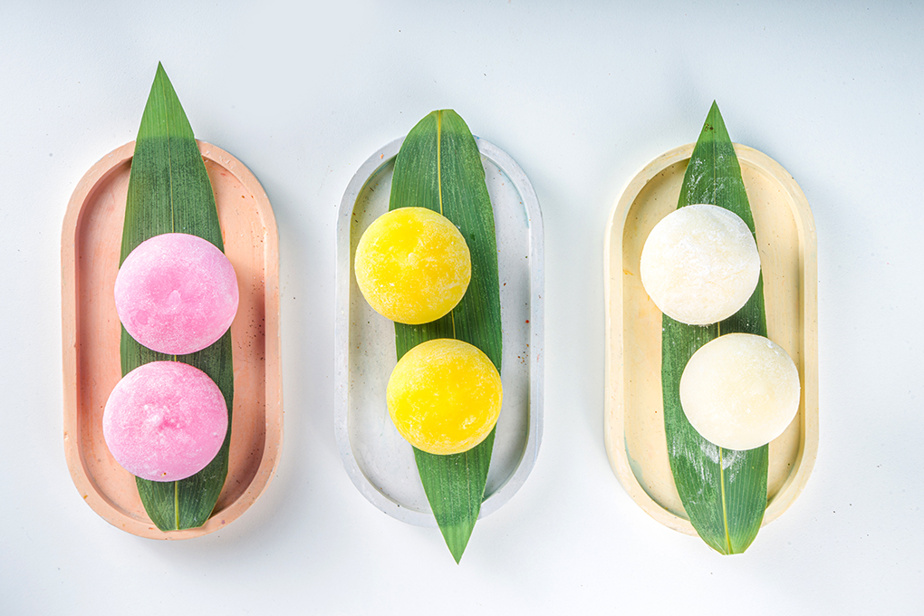Mochi

PHOTO JOSIE DESMARAIS, THE PRESS
A Mochigo mochi-donut
Mochi is essentially a sticky rice paste. The sticky rice used is different from sushi rice, here mochigome is used. It is the high amylopectin content – and the absence of amylose – that gives sticky rice its sticky character. Mochi is said to have originated in China, but to have traveled to Japan at the same time as rice cultivation. It can be found in several forms depending on the regions of Japan.
New Year

PHOTO DOMINICK GRAVEL, LA PRESSE ARCHIVES
Kuniko Fujita, sake sommelier and food critic
Today, mochi is mostly eaten during the New Year in Japan. “The big family gets together and we make mochi,” says sake sommelier and food critic Kuniko Fujita. “We steam the sticky rice, put it in some kind of container, and pound the dough.”
This pounding, called mochitsuki, is commonly done on the street and has even become an event. “This scene is very symbolic of our New Year,” says Kuniko Fujita. Traditionally, mochi means good luck and happiness.”
Daifuku

PHOTO GETTY IMAGES
Daifukus
The type of mochi most commonly found in North America is daifuku. “It’s rice dough on the outside and red bean paste on the inside,” Fujita says. But daifuku can be stuffed with other ingredients, such as ice cream.
Dirty

PHOTO LAUREN JUSTICE, THE NEW YORK TIMES ARCHIVES
Mochi is served savory in this Japanese New Year soup (ozoni).
Mochi can also be eaten salty, in soup – a dish often served at New Year’s – or as a snack. “You can eat mochi wrapped in nori (dried seaweed). You grill it a little and put soy sauce on it like you would for an onigiri.” “, explains Kuniko Fujita.
Mochigo’s Mochi Donuts

PHOTO JOSIE DESMARAIS, THE PRESS
Jenny Khounsombath (center) with Kassem El-Ayoubi (left) and Thi Kim Thanh Tran, who are behind Mochigo
Funny donuts have appeared in Montreal. With the flavor of calamansi, cereal milk, lychee yakult, and formed of several circles, Mochigo’s mochi donuts attract attention.
It was nostalgia that led Jenny Khounsombath, behind Mochigo, to cook mochi donuts. During a trip to Japan, she and her best friend had enjoyed this dessert. They wanted to find some in Montreal, but without success. “We knew they were starting in Toronto, but we weren’t satisfied with their textures, so I said to myself: ‘I’m going to make some,’” Jenny sums up.
The mochi donut combines “the special, very soft texture of mochi and the crunchiness of the donut,” she explains.

PHOTO JOSIE DESMARAIS, THE PRESS
Mochigo’s mochi donuts are a real eye-catcher.
After a lot of testing in her kitchen and searching for the right ingredients—Jenny combines rice, tapioca and wheat flour—she offered them to her Instagram followers. “When I started, people were like, ‘Finally, there are mochi donuts in Montreal,’” she recalls. That’s how Mochigo was born.

PHOTO JOSIE DESMARAIS, THE PRESS
Calamansi-flavored mochi donut
For the past two years, Mochigo mochi donuts have been available as a pop-up store. This summer, customers can pick them up on Saturdays at Espace Warmup on Saint-Laurent Boulevard in Montreal. Jenny Khounsombath is helped by her best friend, Thi Kim Thanh Tran, and her boyfriend, Kassem El-Ayoubi, who have embarked on the sweet adventure.
“Every month, I change the flavors of the frosting. I draw inspiration from my Asian culture,” says Jenny, who is of Laotian descent. “We are growing and seeing what city we want to settle in,” explains the woman who sees interest in mochi-donuts growing even more.
Teta’s Dough Mochikies

PHOTO CHARLES WILLIAM PELLETIER, SPECIAL COLLABORATION
One of the varieties of mochikies, or mochi cookies, prepared by Atef and Yasmeen El-Irani
Mochikies, which translates to mochi cookies, are the brainchild of Atef El-Irani. The engineering consultant and baking enthusiast began offering cookie dough and giant cookies on demand during the pandemic with the help of his daughter, Yasmeen El-Irani, under the name Teta’s Dough.
The Lebanese-Canadian father-daughter duo, who have long lived in Dubai, share a passion for sweets. “We love to combine the essence and flavours of the Middle East with traditional North American sweets,” says Yasmeen.

PHOTO CHARLES WILLIAM PELLETIER, SPECIAL COLLABORATION
Atef El-Irani and his daughter Yasmeen
And the duo likes to experiment. “We wanted to create a new dessert with our giant cookie, which was already very popular, by bringing the unique flavor and texture of mochi,” Atef explains. That’s how the idea of the mochikie was born: a cookie wrapped in mochi. But they had to find a way to make it work.
After many trials – the rice dough had to withstand the baking of the biscuit – Atef El-Irani found the magic recipe, which includes a few secret ingredients, reveals the father.
From the moment it was released, the mochikie turned heads – and delighted many stomachs. “We get a lot of requests to go to Europe, the United States, Halifax,” Atef says. The mochikie’s success has also been fueled by Instagram videos that have racked up millions of views.

PHOTO CHARLES WILLIAM PELLETIER, SPECIAL COLLABORATION
Another variety of mochi-biscuit prepared by Atef and Yasmeen El-Irani
And how do you describe mochikie? “It’s unusual, it’s soft and decadent,” Yasmeen says. Tetas’s Dough comes in a variety of flavors: pistachio, Montreal (chocolate chips with a melting Nutella center), walnut, white chocolate, matcha and lemon. The duo will soon be launching a new dessert: the cookie cloud, which will literally combine mochi and cookie dough.
Teta’s Dough customers can also enjoy a variety of desserts: creamkies (ice cream cookies), crookies (croissant cookies), knafeh and more. For now, the treats are only available for delivery, but Atef and Yasmeen El-Irani would like to open a store in Montreal. “I would like to have that contact with the customers,” Atef says, “to see us cooking.”
